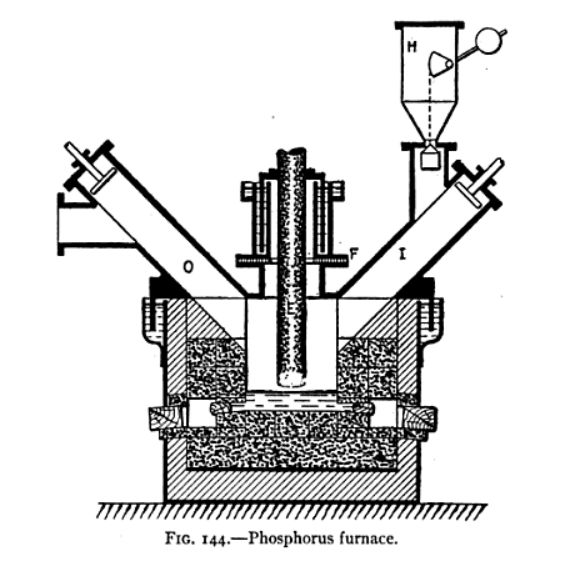6NaPO3 + 10 Al + 3 SiO2 = 6P + 5Al2O3 + 3Na2SiO3
Reduction is performed by heating in a heat resistant tube 25 cm long and 1-1.5 cm in diameter, connected from one side to a source of clean hydrogen
(gas cylinder or kipp's apparatus), and from the other side to a tube, which passes gaseous products into a crystallization vessel filled with water.
The heat resistant tube is filled with a mixture made from 1 weight part of NaPO3, 3 pars of SiO2 and 0.5 parts of aluminium turnings. With a help of
asbestos corks the tube is connected from one side throught a washing bottle, filled with concentrated H2SO4, to a source of hydrogen, and from
another to an outlet tube.
After removal of air from the apparatus using a strong flow of hydrogen and making sure that exiting hydrogen is pure, the heat resistant tube is
heated using a burner with wide nozzle. Phosphorus being formed by the mentioned reaction is distilled and condensed into small balls within
crystallization vessel with water. In dark you can notice a slight glowing of the phosphorus in the tube.
After the experiment is finished, the apparatus is dissasembled only after it has been completely cooled down in a flow of hydrogen.
Obtained phosphorus is put in a bottle filled with cold water.
Sodium metaphoshpate can be prepared by ammonium sodium phosphate hydrate calcination by reaction:
NaNH4HPO4*4H2O => NaPO4 + NH3 + 5H2O |











 :
: 


 And toluene is definitely the most convenient for me, I can buy it by the gallon no
problem. Cant wait to try this out!
And toluene is definitely the most convenient for me, I can buy it by the gallon no
problem. Cant wait to try this out!
 Luckily
I'm only fantasizing right now, usually I'm pretty through with my safety though. And besides I dont actually have the money to buy an
acetylene tank for a single reaction
Luckily
I'm only fantasizing right now, usually I'm pretty through with my safety though. And besides I dont actually have the money to buy an
acetylene tank for a single reaction 











 works out to a 56.25 %yield would be more one big blob caut on fire on surface of water when i let the water get to
hot and the end of the retort tube must of had some left where i couldnt get it with a wire scraper cos i had a nice fire burning out of the tube
after i had shut down cheers nuxy
works out to a 56.25 %yield would be more one big blob caut on fire on surface of water when i let the water get to
hot and the end of the retort tube must of had some left where i couldnt get it with a wire scraper cos i had a nice fire burning out of the tube
after i had shut down cheers nuxy
 ).
). used a new element and think temp was to high measured at 945 deg c with
probe, you get the same effect if you heat the outlet with a gas torch the phos seems to volatile and wont condense and just passes through the
system, will play with settings when i get a chance cheers nuxy
used a new element and think temp was to high measured at 945 deg c with
probe, you get the same effect if you heat the outlet with a gas torch the phos seems to volatile and wont condense and just passes through the
system, will play with settings when i get a chance cheers nuxy










